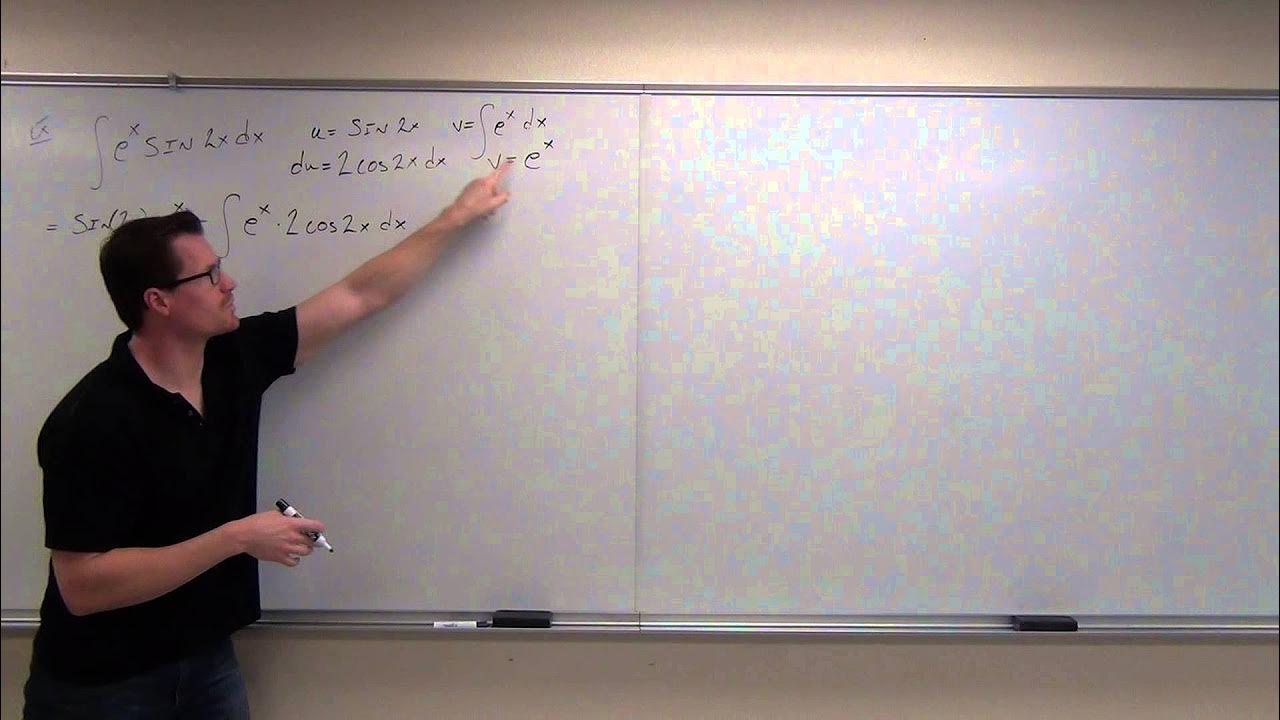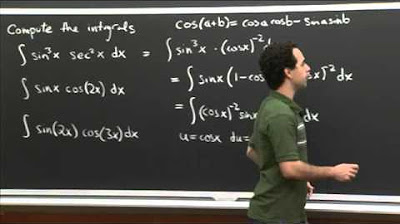Lesson 6 - Trigonometric Integrals (Calculus 2 Tutor)
TLDRIn this advanced calculus tutorial, the instructor dives into the complex topic of trigonometric integrals, which often involve a mix of trigonometric functions and simplifications. The video aims to demystify these integrals by providing a structured approach to solving them. The instructor clarifies that trigonometric integrals differ from trigonometric substitution and offers a general strategy for tackling integrals where the exponents of sine and cosine are odd. The method involves factoring out the trigonometric function with the odd exponent, rewriting the integral using the Pythagorean identity, and then applying substitution to simplify and solve the integral. The video promises to guide viewers through examples to develop an intuitive understanding of these challenging problems.
Takeaways
- 📚 The section focuses on trigonometric integrals, which can be complex due to the variety of trigonometric functions and simplifications involved.
- 🔍 Trigonometric integrals differ from trigonometric substitution, which involves a specific substitution related to trigonometric angles.
- 📈 The integrals often take the form of an integral involving sine to the power of m and cosine to the power of n, where m and n can be different.
- 🔑 A general approach to solving these integrals involves factoring out terms and using trigonometric identities to simplify the expression.
- 📉 If the exponents m or n are odd, a common strategy is to factor out the term with the odd exponent and rewrite the function using the identity cos²x + sin²x = 1.
- 📝 The script emphasizes that there is no one-size-fits-all method for these problems, and a 'feeling' for the approach is developed by seeing examples.
- 🧩 The process involves breaking down the integral into a form that allows for substitution, which can then lead to cancellation and simplification.
- 📑 The example given is the integral of sine cubed x times cosine squared x, which is approached by factoring out sine and using the Pythagorean identity.
- 🔄 The script suggests that while the general approach is helpful, it's not perfect and may not apply to all cases, emphasizing the need for problem-specific strategies.
- 📚 The importance of practice and seeing multiple examples is highlighted as a way to develop an intuition for tackling trigonometric integrals.
Q & A
What is the main topic of this section of the calculus tutorial?
-The main topic of this section is trigonometric integrals in advanced calculus.
Why are trigonometric integrals considered challenging?
-Trigonometric integrals are challenging because there is no single method to solve them; they require a feeling for what needs to be done, which comes from seeing various examples.
What is the general form of the first type of trigonometric integrals discussed in the script?
-The general form of the first type of trigonometric integrals discussed is ∫sin^m(x)cos^n(x)dx, where m and n are powers that can be different.
What is the basic approach to solving trigonometric integrals when the exponents are odd?
-When the exponents are odd, the basic approach is to factor out the term with the odd exponent, rewrite the function using the identity cos^2(x) + sin^2(x) = 1, and then use substitution.
What identity is used to simplify the integral when dealing with trigonometric integrals?
-The identity used to simplify the integral is cos^2(x) + sin^2(x) = 1.
Why is it important not to get too wrapped up in the formula for solving trigonometric integrals?
-It's important not to get too wrapped up in the formula because it's not going to be perfect and may not apply to all cases, but it can help get through most of the cases.
Can you provide an example of a trigonometric integral problem mentioned in the script?
-An example of a trigonometric integral problem mentioned is ∫sin^3(x)cos^2(x)dx.
What is the first step in tackling the example problem of ∫sin^3(x)cos^2(x)dx?
-The first step is to rewrite the integral by factoring out sin(x) since the exponent on sin(x) is odd, leaving sin^2(x) inside the integral.
What substitution technique is hinted at in the script for solving the example problem?
-The script hints at using a substitution technique, although it does not specify which one, after rewriting the function using the identity cos^2(x) + sin^2(x) = 1.
How does the script differentiate trigonometric integrals from trigonometric substitution?
-The script differentiates trigonometric integrals as a broader category of problems involving trigonometry and simplification, whereas trigonometric substitution refers to a specific type of substitution dealing with trigonometric angles in the equation.
Outlines
📚 Introduction to Trigonometric Integrals
This paragraph introduces the topic of trigonometric integrals in advanced calculus. The speaker emphasizes the complexity and variability of these problems, which often involve a lot of trigonometry and simplification without a single method to solve them. The purpose of the section is to provide examples and develop an intuitive understanding of how to approach these integrals. The speaker also clarifies that this section is different from trigonometric substitution, which involves specific types of substitutions related to trigonometric angles in equations.
🔍 Understanding Trigonometric Integrals with Odd Exponents
The speaker provides a general strategy for tackling trigonometric integrals where the exponents of sine and cosine are odd. The approach involves factoring out the term with the odd exponent and then using the Pythagorean identity (cosine squared plus sine squared equals one) to rewrite the function. This allows for the use of substitution to simplify the integral. The speaker illustrates this with an example of integrating sine cubed x times cosine squared x, demonstrating the initial steps of rewriting the integral and setting up for substitution.
Mindmap
Keywords
💡Trigonometric Integrals
💡Advanced Calculus
💡Trigonometric Substitution
💡Sine Function
💡Cosine Function
💡Exponents
💡Factor Out
💡Trigonometric Identities
💡Substitution
💡Integral of Sine Cubed X
Highlights
Introduction to the advanced calculus section focusing on trigonometric integrals.
Trigonometric integrals can be challenging due to the variety of trigonometric functions and simplifications involved.
The importance of understanding that there is no one-size-fits-all approach to solving trigonometric integrals.
Differentiation between trigonometric integrals and trigonometric substitution, which is a specific type of substitution involving trigonometric angles.
The general form of trigonometric integrals involving sine and cosine functions raised to different powers.
The strategy of factoring out the trigonometric function with an odd exponent as a starting point for solving integrals.
Utilizing the Pythagorean identity, cosine squared plus sine squared equals one, to simplify the integral.
The application of substitution as a method to simplify and solve trigonometric integrals.
The emphasis on the need to 'play' with the integrals and not strictly adhere to formulas for problem-solving.
The guideline that if both exponents are odd, factor out the one with the odd exponent.
An example of an integral with sine to the third power and cosine to the second power, and how to approach solving it.
The process of rewriting the integral using the Pythagorean identity to facilitate substitution.
The importance of understanding that the provided guidelines are not perfect but will help in most cases.
The practical demonstration of solving an integral with sine cubed and cosine squared through factoring and rewriting.
The emphasis on the iterative nature of tackling trigonometric integrals and the need to adapt strategies as needed.
The conclusion that the approach to solving trigonometric integrals requires a combination of understanding identities, factoring, and substitution.
Transcripts
Browse More Related Video

Calculus 2 Final Exam Review -

Calculus 2 Lecture 7.1: Integration By Parts

Calculus 2 - Basic Integration

Integration Practice I | MIT 18.01SC Single Variable Calculus, Fall 2010

Changing the Order of Integration (Double Integrals)

Trig Integral Practice | MIT 18.01SC Single Variable Calculus, Fall 2010
5.0 / 5 (0 votes)
Thanks for rating: